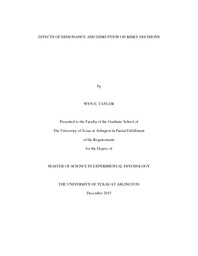
ATTENTION: The works hosted here are being migrated to a new repository that will consolidate resources, improve discoverability, and better show UTA's research impact on the global community. We will update authors as the migration progresses. Please see MavMatrix for more information.
Show simple item record
| dc.contributor.advisor | Levine, Daniel S. | |
| dc.creator | Taylor, Wyn E. | |
| dc.date.accessioned | 2016-01-27T22:03:13Z | |
| dc.date.available | 2016-01-27T22:03:13Z | |
| dc.date.created | 2015-12 | |
| dc.date.issued | 2015-12-22 | |
| dc.date.submitted | December 2015 | |
| dc.identifier.uri | http://hdl.handle.net/10106/25506 | |
| dc.description.abstract | All choices develop first from the basic sensory stimuli to which our systems attend, consciously and unconsciously. The cognitive processes which form the basis of decision- making and contextual shifting require attention to both novel and familiar environmental features; from the overwhelming stimulus that assault our senses, we must figure out which environmental features are safe to ignore and those to which we must attend. Separate fast, emotional and slower rational decision processes described by a number of dual-processing theories have found compelling support in neuroscience research examining selective attention gating mechanisms. Indeed, these two systems appear to exert substantial influence over attentional mechanisms; therefore any interplay between these systems is of great interest.
Ideally, people need to be able to handle uncertainty and pressure while benefiting from heightened emotional, intuitive quickness, associated with clear survival implications, without losing access to their slower reasoning mechanisms due to overwhelming emotional or environmental stimuli ; that is, if they are to make truly optimal decisions in changing contexts. An increased understanding of how these processing systems influence human attention mechanisms would therefore contribute to efforts to improve decisions, especially quick decisions. Furthermore, a better understanding of how to actively up- and/or down-regulate these systems could prove both informative and valuable.
The current behavioral research aimed to test some of the implications of the proposed relationships between several brain areas related to selective attention by examining behavioral evidence of dual-processing. The purpose of this study was to examine the effects of cognitive disruption and cognitive dissonance on performance of a simulated gambling task known to elicit both emotional, system-1 processing, as well as rational, system-2 processing. Results failed to support my predictions. Limitations and implications for future research are discussed. | |
| dc.format.mimetype | application/pdf | |
| dc.language.iso | en_US | |
| dc.subject | Attention | |
| dc.subject | Selective attention | |
| dc.subject | Gating mechanisms | |
| dc.subject | Dual-processing | |
| dc.subject | IGT | |
| dc.subject | Iowa Gambling Task | |
| dc.subject | Gender differences | |
| dc.title | EFFECTS OF DISSONANCE AND DISRUPTION ON RISKY DECISIONS | |
| dc.type | Thesis | |
| dc.date.updated | 2016-01-27T22:05:20Z | |
| thesis.degree.department | Psychology | |
| thesis.degree.grantor | The University of Texas at Arlington | |
| thesis.degree.level | Masters | |
| thesis.degree.name | Master of Science in Psychology | |
| dc.type.material | text | |
| dc.creator.orcid | 0000-0002-4591-2201 | |
Files in this item
- Name:
- TAYLOR-THESIS-2015.pdf
- Size:
- 675.3Kb
- Format:
- PDF
This item appears in the following Collection(s)
Show simple item record


